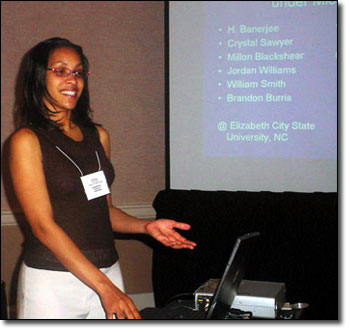|  The
NASA/NSF/TSU Research Symposium in Nashville, Tennessee was an outstanding
event. The overall atmosphere was relaxing and user friendly. There
were ample opportunities to develop relationships with the researchers,
students, presenters, and professors. The
NASA/NSF/TSU Research Symposium in Nashville, Tennessee was an outstanding
event. The overall atmosphere was relaxing and user friendly. There
were ample opportunities to develop relationships with the researchers,
students, presenters, and professors.
The conference was a very motivational and inspirational experience
to continue to pursue my goals and my future endeavors. The conference
broadened my horizon by making me aware of the opportunities that
are in the biology field and how to relate biology to NAS, along
with other majors. It also exposed a sense of diversity between
the people, the school locations, and the different areas of study
beyond a BS degree. With the opportunity to meet academically excelled
students and professors from other colleges and areas it allowed
a mentoring session to arise, which helped to determine the future
path I wanted to explore.
On Thursday, the speaker for the luncheon was Mr. James Harrington,
from Goddard Space Flight Center and MU-SPIN, who also was funding
administrator for NASA’s future projects. Mr. Harrington elaborated
on the need of the student to not only do the research, but to know
why he or she may be doing it and how it relates to NASA and the
world. He explained how a majority of the research students do has
some kind of effect on the world, as we know it. In addition, Mr.
Harrington showed the significance of the research at NASA. In a
few years the world’s atmosphere is eventually going to be
deteriorated, therefore we need to know if there is another planet
capable for living. If so, are we going to be the only species living
there and if we aren’t then will it actually be safe environment
or where else could we live. Mr. Harrington made the students ask
themselves questions like this to let us see how the research that
we do today will have some effect on us tomorrow. Another speaker,
on Friday, was Ms. Montanez Wade from Tennessee State University
who spoke on the Diversity of the Technical Landscape through Student
Development. Ms. Wade encouraged the students to pursue furthering
their education and to explore all that you want to know whether
it is in your field or not. She explained how everybody should want
to learn and know why things happen and how. When you want to learn
all that you can, eventually you will be a diverse, well-rounded
individual. To learn all that life has to offer is what we all should
aim for. Also, a research student from Tennessee State, La Tasha
Taylor, happened to leave some personal inspiration. Latasha is
a double major in Aeronautical Sciences and Engineering with a minor
in Biology. She helped  develop
the C++, Java, and other computer programming in digital cameras.
As well as created a computer program designed to help people from
second grade level to professor or doctorial level and higher, with
the understanding of carbohydrates. Also due to having a successful
research with Tennessee State University’s Isolated Gravity
Experimental Reduction System: Vibration Isolation for Low Gravity
Science, she along with three other student researchers will have
the upcoming experience of flying on the test shuttle at the NASA
Space Flight Center. This allows the actual anti-gravity sensations
as if they were on a real trip to space. Latasha’s accomplishments
as a senior undergraduate weren’t the most inspirational,
but to know that she is a young female African American that gave
me the most satisfaction. develop
the C++, Java, and other computer programming in digital cameras.
As well as created a computer program designed to help people from
second grade level to professor or doctorial level and higher, with
the understanding of carbohydrates. Also due to having a successful
research with Tennessee State University’s Isolated Gravity
Experimental Reduction System: Vibration Isolation for Low Gravity
Science, she along with three other student researchers will have
the upcoming experience of flying on the test shuttle at the NASA
Space Flight Center. This allows the actual anti-gravity sensations
as if they were on a real trip to space. Latasha’s accomplishments
as a senior undergraduate weren’t the most inspirational,
but to know that she is a young female African American that gave
me the most satisfaction.
Lastly, the NASA conference was used as a learning tool. Traveling
there has given insight to other fields to pursue, such as Astrobiology.
It has given an intuition of what to expect to encounter in further
study and most of all to see the world outside of ECSU and myself,
which has expanded my mind to shoot for the stars and try to literally
touch the moon.
Crystal
Sawyer, ECSU Research Student
|

